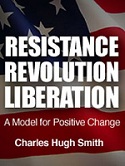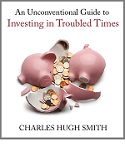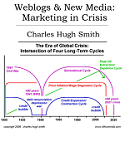

|

|
|||||||||||||
|
The Nearly-Free University (November 15, 2012) The Nearly-Free University model would revolutionize higher education, enabling a universally accessible college education at a very low cost. The key to understanding higher education in the U.S. is to grasp that it is at heart just another debt-dependent neofeudal cartel. In other words, it is just like sickcare and the national defense complex. Each cartel shares these features: 1. Compelling PR "cover" for cartel extraction of wealth. "Healthcare" (i.e. sickcare that profits from illness, not health) is a "right." The defense industry is the bulwark of democracy, and "educating our children" is the key to future prosperity. Each portrays itself as sacrosanct. These "Mom and apple pie" cover stories enable monopolistic exploitation: $300 million a piece fighter aircraft (replacing $54 million aircraft), $150,000 college diplomas, and "healthcare" spending that is two times more per capita than competing advanced democracies. 2. Government (monopoly) protection and funding. The largest monopoly is of course the Central State, which holds a monopoly on taxation, coercion and distribution of swag. All these cartels have gained control of Federal (monopoly) funding. 3. Illusory competition. Each cartel is protected by wide, deep regulatory moats and complexity fortresses that protect the Status Quo income streams from any real competition or innovation. Within each cartel, meaningless variations in price are offered as "proof of competition," but everyone knows the price of each cartel's "product" ratchets higher, regardless of conditions in the real economy. That's the way cartels and monopolies work. The most implacable enemy of innovation is monopoly. If you're protected from real competition, then you have no incentive or need to innovate. That is the essence of cartel-capitalism and the neofeudal model. In the case of the higher education cartel, the Federal funding is both cash grants and loans issued to newly minted debt-serfs. Student loans cannot be discharged in bankruptcy like other debt; these loans have ballooned to about $1 trillion. This is the essence of the neofeudal model: a protected Elite parasitically extracts wealth from the debt-serfs below. Should the debt-serfs resist, the State steps in to coerce compliance. The problem with protected cartels (neofeudal fiefdoms) is that they are unsustainable. Freed of any competitive pressure or need to innovate, cartels inevitably follow an S-Curve of diminishing returns: it takes more and more money just to sustain the bloated Status Quo, even as the value created by the cartel declines.
For a taste of diminishing returns in the higher education cartel, please read Bureaucrats Paid $250,000 Feed Outcry Over College Costs (via Maoxian). Yes, top research universities have to manage grants and research projects; but only a relative handful of universities need enormous administrative staffing, and even fewer can justify paying managers $250K+ each. All Federally protected cartels are living off debt. One in every three Federal dollars is borrowed, and this doesn't even count the $1 trillion in student debt which is nominally private-sector debt. Debt that skyrockets higher while the real economy that supports it stagnates is unsustainable. As I note in my new book Why Things Are Falling Apart and What We Can Do About It, complex systems based on diminishing returns collapse under their own weight and are replaced by systems that are simpler, faster and affordable. This can be a conscious process or it can be a default process, where the system becomes increasingly fragile and then suddenly undergoes a phase-shift that is widely viewed as "impossible," i.e. the system freezes up or collapses. The Internet has already opened up an alternative to the neofeudal higher-education cartel. I call it The Nearly-Free University, a development I anticipate will take shape within the next decade. Once the model has been proven, it will rapidly spread, as it is a very advantageous adaptation that is faster, better and cheaper than the present bloated cartel. The entire education industry on the U.S. is based on an inflexible, increasingly marginal-return "factory model," something I have written about since 2005. Is Our Education System Based on a Factory Metaphor? (November 15, 2005) We are "training" millions of people in an assembly-line based on the assumption that academia is a limitless growth industry, when in fact it has reached the zenith of diminishing-return complexity and cost. The Nearly-Free University may or may not have a physical plant. If it does, it will be a cheap re-use facility such as an abandoned office park or factory. It may not have a physical headquarters at all; "classes" may meet in cafes when the need arises. This is the new distributed model of global corporations, some of which have no headquarters at all. Physical plant is now unnecessary for pretty much everything but lab work. In the current high-cost model, the physical plant only available at certain times and in a specific locale. The Nearly-Free University would be available anywhere there is an Internet connection and other people willing to self-organize and collaborate. In many cases, if space is required, it could be shared. Vast campuses are no longer needed. The coursework will largely consist of free lectures and tutorials from non-profits like the Kahn Institute or classes already distributed for free online by institutions such as Stanford and M.I.T. In place of costly professors and overworked, underpaid non-tenured teachers, the instruction will be overseen by part-time mentors from the real world who act as guides, occasionally lecturing but more often encouraging peer-to-peer tutoring and collaborative projects that are not "study groups" but actual work projects that produce something of value in the real world. The mentor is a working professional who "works" at the Nearly-Free University on a flex-time basis. Their "job" is to suggest a practical foundation of basic courses in the student's chosen field; these courses are taken while the student is engaged in the core curriculum, which are the work projects. These mentors choose to devote time to Nearly-Free University because they enjoy it; their fee will be modest. Most will work part-time while they pursue their primary career. Students will move seamlessly from online coursework to projects undertaken in real-world enterprises and communities, learning by doing and from collaboration with others in self-organizing groups. Mentors would have access (as in the Kahn Institute's classroom software) to a visual display of the student's coursework and work-project progress. Student would be encouraged to earn money via the work projects undertaken. Instead of owing $120,000 after four years of passive study, students might complete their University experience with earnings in the bank. Very few people continue on to research or scholarship within academia, corporations or the national laboratories. A relative handful of large research universities would be enough to train those who needed PhDs for scholarship or high-level research. The Nearly Free University model would educate the 95% who do not need PhDs. Instead of an essentially opaque diploma—what exactly does a diploma communicate about the student's mastery, interests, coursework or accomplishments? —students will be issued a C.V./resume listing all their completed courses and their work projects. Prospective employers would be able to scan this C.V. and get a real sense of the person's coursework, mastery and work results in the real world. A decentralized non-profit network of organizations would arise to accredit the coursework shared by the Nearly-Free Universities. There would be no centralized “gatekeeper” that could demand a premium for its accrediting or testing services. Verification of coursework, work history and skillsets would be provided by multiple-sourced, voluntary transparent networks on the Web. Credentialing is another system that has reached the top of the S-Curve and is slipping into stagnation and decline. What you can accomplish in the real world will rapidly become more valuable than a credential such as a conventional college degree. The credentialing gatekeepers are protecting an "asset"--the college diploma--that is largely a phantom asset for the vast majority of students. The total cost of the Nearly-Free University might be $3,000 tuition and fees for 3-4 years compared to $60,000+ today. (This does not include room and board, of course.) The credential issued upon “graduation” (an arbitrary concept in an economy that rewards perpetual learning and improved skills) would be secondary to what the student has learned to create, accomplish, fix and innovate in the real world. This is how innovation works: costs don't decline by 5%, they decline by an order of magnitude. There would be no student loans. The low costs of the Nearly-Free University would be paid in cash or hours of labor that the University could “cash” for goods or services it needed to operate in a cash-free labor exchange. Like many of the concepts discussed in this blog, this model is considered "impossible" within the confines of the Status Quo even though it is the only truly sustainable model of universal education. The value of higher education for many is the network they establish during their university years. The Nearly-Free University model actually enables far more robust networks to self-assemble than the static, high-cost classroom model. "Lifelong learning" would not be a cliche in the Nearly-Free University, it would be an affordable, dynamic, exciting reality.
The Nearly-Free University is just one "faster, better, cheaper" alternative I discuss in
Why Things Are Falling Apart and What We Can Do About It,
currently offered at 20% to 30% discounts this week only.
Things are falling apart—that is obvious. But why are they falling
apart? The reasons are complex and global. Our economy and society have structural
problems that cannot be solved by adding debt to debt. We are becoming poorer, not
just from financial over-reach, but from fundamental forces that are not easy to identify
or understand. We will cover the five core reasons why things are falling apart:
 1. Debt and financialization
1. Debt and financialization
2. Crony capitalism and the elimination of accountability 3. Diminishing returns 4. Centralization 5. Technological, financial and demographic changes in our economy Complex systems weakened by diminishing returns collapse under their own weight and are replaced by systems that are simpler, faster and affordable. If we cling to the old ways, our system will disintegrate. If we want sustainable prosperity rather than collapse, we must embrace a new model that is Decentralized, Adaptive, Transparent and Accountable (DATA).
We are not powerless. Not accepting responsibility and being powerless are two sides of
the same coin: once we accept responsibility, we become powerful.
To receive a 30% discount on the print edition: $16.80 (retail $24), follow the link, open a Createspace account and enter discount code B9G5JDXD. (This is the only way I can offer a discount.) 



Please click on a book cover to read sample chapters
NOTE: gifts/contributions are acknowledged in the order received. Your name and email remain confidential and will not be given to any other individual, company or agency.
"This guy is THE leading visionary on reality.
He routinely discusses things which no one else has talked about, yet,
turn out to be quite relevant months later."
Or send him coins, stamps or quatloos via mail--please request P.O. Box address. Subscribers ($5/mo) and contributors of $50 or more this year will receive a weekly email of exclusive (though not necessarily coherent) musings and amusings. At readers' request, there is also a $10/month option. What subscribers are saying about the Musings (Musings samples here): The "unsubscribe" link is for when you find the usual drivel here insufferable.
All content, HTML coding, format design, design elements and images copyright © 2012 Charles Hugh Smith, All rights reserved in all media, unless otherwise credited or noted. I am honored if you link to this essay, or print a copy for your own use.
Terms of Service:
|
Add oftwominds.com |